The Nelson Railway…to Nowhere
Contents |
Despite more than 80 years of drive and determination on the part of Nelsonians to work towards a railway that would end their isolation from the rest of the South Island, the resulting line was destined to be the railway to nowhere.
Save our Railway
Nelsonians had dreamed of a railway that would link them to the rest of the South Island from as early as the 1860s.
Permission was finally given in 18711 to start work on a line intended to meet up with the main trunk line. Construction of the first 30.4 km stage, from the city to Foxhill, began in 1873 and it opened in 1876.2 The line followed St Vincent Street, rather than the publicly favoured port route. It went over the relatively steep gradient of Bishopdale and through Stoke, Richmond, Brightwater and Wakefield, to Wai-iti, just short of Foxhill.3
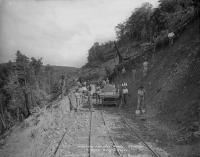 Belgrove construction work by Midland Railway Company, The Nelson Provincial Museum, Tyree Studio collection, 179476/3
Belgrove construction work by Midland Railway Company, The Nelson Provincial Museum, Tyree Studio collection, 179476/3Click image to enlarge
An economic recession forced the suspension of construction until 1879-1880, when an extension to Belgrove was built.4
Meanwhile, in 1878, work had started on widening Haven Road to accommodate a line from the city to Government Wharf at Port Nelson.5 This followed the route of the closed Dun Mountain railway line and was opened in 1880.6
Work began on the Belgrove to Motupiko (Kōhatu) section in 1890. A work camp was established and a 1352m tunnel built through the Spooners Range.7 This section opened in 1897, and in 1901 a start was made on the 16 km stretch to Tadmor, via Tapawera. A rail and road bridge across the Motueka River was completed in 1906.8
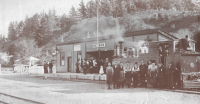
Nelson Railway 1890's. Tyree Collection. Nelson Provincial Museum
Frustrations grew over the time taken to build the railway. It had taken 33 years to build just 66 km of track.9 The line had been extended from Tadmor, through Kiwi, Tui and Kākā to Glenhope10 by 1912. Construction was again suspended, however, and the outbreak of war in 1914 brought a further halt.11
A 6km extension to Kawatiri began in 1920 and the Pikomanu railway camp was established the following year. A tunnel of 185 m was cut, two bridges built across the Hope River and the section opened in June 1926.12
Services were reduced in the 1920s, with passenger numbers and freight volumes having decreased due to the rapid development of road freight and passenger transport. The Nelson Progress League was established in 1924 to campaign for the line to be extended to join the main trunk. It launched a pamphlet in 1925 calling on the Government to “Fill the Gap”.13
Between 1924 and 1929 a 6 km section was built to Gowanbridge, but this was only ever used for freight. With the country reeling from the Depression, all work on the railway was suspended from January 1931, terminating the employment of 300 men.14
The gap between the completed section of line and Inangahua Junction, where it could connect with the main trunk line, was less than 70 km (42 miles).15
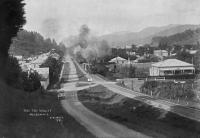 Toi Toi Valley train, The Nelson Provincial Museum, FN Jones Collection, 26713
Toi Toi Valley train, The Nelson Provincial Museum, FN Jones Collection, 26713 Click image to enlarge
The Nelson to Glenhope railway ran at a loss for most of its life, and was under constant threat of closure. Cost cutting resulted in services being run down and road transport became an increasingly attractive alternative. From 1931 the line was under constant threat of closure and people were urged to “use it or lose it”. It was announced in 1952 that the Nelson line would remain open only until major highways were completed. Rail services were suspended in 1954.16
A public meeting resulted in a 12,000-signature petition calling for a change of the decision. The Prime Minister, Sid Holland, issued a challenge to Nelson to save its railway by guaranteeing 25,000 tons of rail freight per year. On June 12, 1954, an excursion took 400 passengers on “the last train to Glenhope”. A few days later the Progress League accepted the Prime Minister’s challenge and the line re-opened. Despite its best efforts, the League fell short of the target and the line was set for closure on September 3, 1955.17
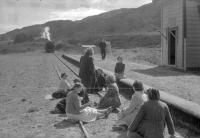 Kiwi Protest 1955, The Nelson Provincial Museum, Geoffrey C Wood Collection, 8830 fr38
Kiwi Protest 1955, The Nelson Provincial Museum, Geoffrey C Wood Collection, 8830 fr38 Click image to enlarge
The last timetabled train arrived in Nelson on Friday September 2, 1955 and there was a last-ditch public meeting on the Church Steps.18 Ruth Page called her own women’s protest meeting, on hearing that work would start on pulling up the railway lines at Kiwi on September 20th.19 A group of women, led by Ruth and Sonja Davies, held a week-long sit-in on the line at Kiwi, with nine of them being arrested and convicted when they refused to move. It was to no avail, and the railway line, so desperately wanted and so long under construction, was gradually dismantled.20
The dream was over.
2008 (Updated 2022)
Working on the railway - a personal account
Amber Haley worked at the Railway Office in 1940. She came from a radical family – her mother Mary Ethel Hunter had been a prohibitionist and involved with the Suffrage movement, and her father had been taught by Frederick Alley, father of Rewi Alley – the Kiwi Communist of the period. Rewi Alley’s mother was Kate Sheppard’s secretary.
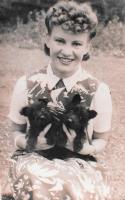
Amber Haley nee Hunter 1940s. Courtesy Margot Haley
This is an excerpt from Amber Elsie Hunter’s life story (contributed by daughter Margot Haley)
The NZ Railways in Gloucester St advertised for someone on July 18th 1940 my father's 60th birthday and I was taken on as their office junior.
Mr Syd Jenks was the Stationmaster and Fred Potton the senior clerk at the Nelson station. My duties were mainly typing letters a bit of clerical work and taking padlocked leather bags which had come in on the train from the country stations at Glenhope, Wakefield and Richmond as well as the Nelson station to the Bank of NZ in Trafalgar St.
The railway office was a pleasantly warm place to work through the winters as they had a big open fireplace which were amply supplied with big buckets of coal. Some of the well known Railway identities form that era were Mr Abrahams the train driver, with the nickname of 'Windy' or 'Sousa' as he was also a stalwart in the Municipal Band. 'Spot' Westrupp and Don Lucas who were the firemen and later drivers. Mr Morrison, Bert Goldsmith and 'Doug' Garguilo were the guards. Doug's full Italian name was Dudley Wilkes Guiseppe Garguilo always stayed in my memory! There was Alan Godbaz, Evan Borlase the office-boy and Clarence Bull office clerk as well as many gangers and surface men living in the country areas who were responsible for the maintenance and good condition of the rail-way lines and surrounds".
2018
Tools
Sources used in this story
-
Voller, L. (1991). Rails to nowhere. Nelson, N.Z.: Nikau Press, p.25
-
McAloon, J.(1997). Nelson: A regional history. Whatamango Bay, N.Z, Cape Catley Ltd., p.107; Voller, pp.28,33,35.
-
O’Donnell , B. (2005), When Nelson had a railway: The life and death of New Zealand’s last isolated railway, 1876-1955. Wellington, N.Z: Schematics Ltd., pp.18-22, 34-61.
-
Voller, p.50.
-
O’Donnell, pp.24-33.
-
Voller, p.74.
-
Voller p.62-73.
-
O’Donnell, 92-107; Voller, p.87
-
Voller, p.89.
-
O’Donnell, pp. 106,110,112-131,186-9.
-
McAloon, p.123.
-
Voller, pp. 116,119-122; O’Donnell, pp.132.
-
McAloon, p.188; Voller, pp.114-5,124
-
O’Donnell, pp.133-5; McAloon, p.172.
-
Voller, p.136.
-
Voller, p.139.; McAloon, p.188, O’Donnell, pp.197-199
-
Voller, p.161-2,167; O’Donnell, pp.205-235
-
O’Donnell, pp.236-239.
-
Davies, S. (1984), Bread and roses. Auckland, N.Z: David Bateman Ltd, pp.98-105.
- O’Donnell, pp.247-273.
Want to find out more about the The Nelson Railway…to Nowhere ? View Further Sources here.
Related Stories
Do you have a story about this subject? Find out how to add one here.
Comment on this story
Further sources - The Nelson Railway…to Nowhere
Books
- Acton, W. and Adams, B. (1878). The Nelson and W.C. section of the Main Trunk Railway of New Zealand: A letter to the Hon. James MacAndrew, Minister of Public Works. Nelson, N.Z: R. Lucas and Son.
http://www.worldcat.org/oclc/154253896 - Bell, C.W. (1978). Unfinished business: The second fifty years of the Nelson City Council. Nelson, N.Z.: Nelson City Council.
http://www.worldcat.org/oclc/34523816 - Broad, L. (1892). The jubilee history of Nelson from 1842-1892, Nelson, N.Z.: Bond, Finney and Co, and Colonist Office.
http://www.worldcat.org/oclc/35010468 - Brown, Margaret C. (1976). Difficult country: An informal history of Murchison. Nelson, N.Z.: Murchison Historical and Museum Society Inc.
http://www.worldcat.org/oclc/3241265 - Churchman, G.B. (1990) Railways of New Zealand. Auckland [N.Z.] : Collins, pp. 172-176.
https://tepuna.on.worldcat.org/oclc/49988738 - Coney, Sandra Coney (1993). Standing in the sunshine: a history of New Zealand women since they won the vote. Auckland, N.Z: Penguin Books.
http://www.worldcat.org/oclc/29192742 - Davies, Sonja (1993). Bread and roses. (2nd ed.). Auckland, N.Z: David Bateman Ltd.
http://www.worldcat.org/oclc/17576454 - Dry Crust Communications Ltd (2008), Business vitality; Celebrating 150 years of the Nelson Tasman Chamber of Commerce. Nelson, N.Z.: Nelson Tasman Chamber of Commerce.
http://www.worldcat.org/oclc/223467840 - East & West Coast & Railway League (1886). East and West Coast and Nelson railway history of the effort made by the people of Canterbury, Westland and Nelson, to obtain this railway and a summary of reasons for its construction. Christchurch, N.Z. : Executive Committee of the Railway League.
http://www.worldcat.org/oclc/154604659 - Gregory, Kenneth (1976). Land of streams: Life in the Waimea County Province of Nelson 1876-1976. Nelson, N.Z.: Waimea County Council.
http://www.worldcat.org/oclc/3312229 - Grigg, John.R. (1947). Murchison, New Zealand: How a settlement emerges from the bush. Nelson, N.Z.: R. Lucas and Son (Nelson Mail) Ltd.
http://www.worldcat.org/oclc/154274839 - Hill, Cathie and Peerson, Sheena (eds.), (2005). Kiwi heroines: Honouring the memory and capturing the stories of Nelson women’s ‘Save Our Rail Protest’ at Kiwi, September 1955. Nelson, N.Z.: In Their Tracks Collective.
http://www.worldcat.org/oclc/156753125 - Lee, John A. (1977) Early days in New Zealand. Martinborough : A.Taylor.
http://www.worldcat.org/oclc/4809152 - McAloon, J.(1997). Nelson: A regional history. Whatamango Bay, N.Z, Cape Catley Ltd.
http://www.worldcat.org/oclc/50310188 - Markwell, Carol (1990). Save our railway: A dramatised history. Nelson, N.Z. The author.
http://www.worldcat.org/oclc/154129198 - Nelson Provincial Progress League (1931). The case for filling the gap in the Midland Railway. Nelson, N.Z.: Betts & Son [held Nelson Provincial Museum]
- Nelson Provincial Progress League (1954, July 20). New Zealand Railways Nelson Section, Report to the Rt. Hon. Prime Minister by Railways Advisory Committee of the Nelson Provincial Progress League. Nelson, N.Z.: Nelson Provincial Progress League.
http://www.worldcat.org/oclc/156760553 - Newport, J.N.W. (1978). Footprints too: Further glimpses into the history of Nelson Province. Nelson, N.Z: self-published.
http://www.worldcat.org/oclc/5829428 - Newport, J.N.W. (1978). More footprints: Still further glimpses into the history of the Nelson Province. Nelson, N.Z.: self-published.
http://www.worldcat.org/oclc/37444985 - New Zealand Railways (1981) Working timetable Picton Nelson Westport sections November 1938. Wellington, N.Z. :New Zealand railway and Locomotive Society.
http://www.worldcat.org/oclc/154241721 - O’Donnell , B. (2005), When Nelson had a railway: The life and death of New Zealand’s last isolated railway, 1876-1955. Wellington, N.Z: Schematics Ltd.
http://www.worldcat.org/oclc/123031013 - Parr. W.H. (1979). Port Nelson, gateway to the sea: A history of the Nelson Harbour Board to 1978. Nelson, N.Z.: Nelson Harbour Board.
http://www.worldcat.org/oclc/154321043 - Smith, Dawn (2005). Nelson Historical Society: The first 50 years, 1954-2004. Nelson, N.Z.: Nelson Historical Society.
http://www.worldcat.org/oclc/166309319 - Sutton, Jean. (1992). How Richmond grew. Nelson, N.Z.: self-published.
http://www.worldcat.org/oclc/34876506 - Voller, L. (1991). Rails to nowhere. Nelson, N.Z.: Nikau Press.
http://www.worldcat.org/oclc/30896868
Articles
- Breaking the law; Third day of protest to continue (1955, September 27, 28 & 29) Nelson Evening Mail.
- Britten, Rosemary (1992, March). End of the line, North & South, pp.14-15.
- Clark, Karen (2005, 31 August). Track record, Nelson Mail, p.23.
- Grzelewski, Derek (1997, Oct/Dec). Buller the mighty river, New Zealand Geographic, 36, pp.20-47.
- Harris, Alan (2000, 1 March) Election promise immortalised. Marlborough Express, p.5.
- Hindmarsh, G. (2021, April 7) Rail shame as Nelson left without trains despite feisty protest. Nelson Mail on Stuff:
https://www.stuff.co.nz/nelson-mail/news/300277523/rail-shame-as-nelson-left-without-trains-despite-feisty-protest - Newport, J. (1981, Oct). Transport by rail and road Journal of Nelson and Marlborough Historical Society. 1, 1. p.33-35.
http://www.nzetc.org/tm/scholarly/tei-NHSJ04_01-t1-body1-d8.html - Nine women arrested (1955, September 30) Nelson Evening Mail.
- Preston, Gaylene (2005, 25 June – 1 July), Obituary for Sonja Davies. The Listener, pp. 24-25.
- Railway demolition held up by women (1955, September 23) Nelson Evening Mail.
- Sit down protest to continue (1955, September 24) Nelson Evening Mail.
- Tui station not the end of the line (2008, 30 August), Live Nelson, Nelson City Council, Issue 234.
- Voller, L. (1987, December 12) Nelson's sage of trunkline fever. Nelson Evening Mail.
- Ward, Nick (1996, 7 October). Line to nowhere not forgotten. Nelson Mail, p.3.
- Williams, J. (2002, April/May). The Nelson train. New Zealand Memories, 35, p.26-28.
- Women's bid to save railway start today (1955, September 23) Nelson Evening Mail.
Other
Film and Television
- Excerpts from Bread & Roses (1993) by Preston Laing productions and telling the story of Sonja Davies. Available on NZ on Screen.
https://www.nzonscreen.com/title/bread-and-roses-1993/overview
Nga Taonga Sound & Vision:
-
Personal record, Mckee, Tas. [Railway protests in Nelson](1955):
https://www.ngataonga.org.nz/collections/catalogue/catalogue-item?record_id=70419 - The last train (1955) available from Ngā Taonga Sound & Vision:
https://www.ngataonga.org.nz/collections/catalogue/catalogue-item?record_id=72692
Photographs
- In Their Tracks September 1955-2005 Calendar, (2006), Nelson, N.Z.: In Their Tracks Steering Group. [A Collection of photographs from the protest at Kiwi Station, September 1955 [Held in Heritage Room, Nelson Public Libraries and at Tasman District Libraries]
Unpublished Resources
[held The Nelson Provincial Museum]
- Field, L, William, L & Hemming, T.A. (1900-1960) Collection. AG412 Box 5 Railway
- Firtzgibbon, A. (1863) Waimea Railway Plan. M1675
- Jenks, C.F.L. (1947-1957) The Nelson Railway. QMS JEN
- Jenks, C.F.L. (1947-1957) Nelson railway scrapbook. qMS JEN.
- Lucas, W.D.A. (1955) Train Advice No 73: last train from Nelson - Glenhope UMS 457
- Nelson Provincial Progress League (1931) Papers re railway. AG 399
- Voller, Lois (1896-1985) Railway research papers. AG 396
Visit sites associated with the old Nelson railway line - check our map
Nelson
-
Nelson railway station. A memorial marking the site of the Nelson railway station is on the corner of Gloucester and St Vincent Streets where the fire station now is.
-
Founders Park Atawhai Drive, Nelson. Home of the Nelson Railway Society, which has created a railway characteristic of the old Nelson to Glenhope line. Restored trains, identical to the type and class of those used on the Nelson line, run between the park and Sovereign Street, with plans to extend the line further. A workshop at the park has restoration projects underway and passengers on the short rail journey can stop at one of three stations: the Wakefield Quay Station at the park - originally an NZ Railways freight building located behind the Customhouse at Port Nelson); Tui station, which was restored and moved from the Tui Property in 2008; and the Grove Station at Sovereign Street, which was the old Spring Grove rail station. There is a display about the railway at Wakefield Quay Station.
-
Walter’s Bluff. The hillside opposite Founders Park (Atawhai Drive, Nelson) received its name after a 1960 election year promise made by the Prime Minister Walter Nash, that a rail link would be built between Nelson and Marlborough, came to nothing. The proposed line was to have started from a station on reclaimed mudflats near Trafalgar Park and run along the waterfront to Wakapuaka and on to Havelock to join the main trunk line between Picton and Blenheim. Mr Nash posed for a photograph with his foot on the first load of spoil dumped on the site of the proposed station but the project was scrapped when a new government was elected. A sign was erected on the hillside with the slogan “Walter’s Bluff,” a name that stuck.
-
Railway Reserve. This public corridor follows the route of the railway line out of the city to the Wakatu Estate. A 15 km stretch of it is sealed with foot and cycle paths. Follow the maps and route directions on Nelson City Council’s website to traverse the reserve from the city to Stoke. Towards the Saxton Road end of the reserve, view Mike Hindmarsh’s “Arrival and Beginning” sculpture, made of railway sleepers.
Tasman
-
Railway Reserve - The reserve walkway continues as part of Tasman's Great Taste Trail from Queen Street, Richmond to State Highway 60 at Appleby, running parallel to Gladstone Road. The old railway overbridge at the Appleby end was built in 1930 after three fatal road accidents prompted a safer route across the railway track. Despite the lack of a railway these days, the traffic overbridge remains in use across the railway reserve. See the Heart of Biking website for a map and route direction.
-
Belgrove railway windmill. This is the best remaining example of a wooden railway windmill in New Zealand. It was used to pump water for the engines beginning the steep climb to the tunnel through the Spooners Range. There were originally 100 in use and this one operated between 1898-1955. See the information on Heritage New Zealand.
-
Spooners Tunnel. This is New Zealand’s longest closed tunnel at 1352 m long and its summit is 303 m above sea level. It took 15 months to complete (1890-1892) with 15 men working 3 shifts each with pick and shovel and a team of men and boys making concrete blocks. Spooners Tunnel is now part of Tasman's Great Taste Trail. The railway line is no longer in place apart from some tōtara sleepers, but there are cave weta, worms and fungi. Location map
-
Kiwi Station. The original Kiwi station near where the protest sit-in of a group of Nelson women took place in 1955, has been relocated to Tapawera where it is now used as an information centre.
-
Glenhope Station. This is still situated at Glenhope and is being used as a storage shed.
-
Kawatiri Tunnel. The tunnel took three years to build, some of it hand-drilled through quartz. It was finished in 1923 and is at Kawatiri Junction, 24 km south of Lake Rotoiti. The short walkway goes through the tunnel and includes a rail bridge and the site of the Kawatiri station. Interpretation panels give detailed information about the Nelson to Glenhope railway line. Opposite the tunnel is the site of the Pikomanu camp where several hundred railway workers lived. Location map.
Web Resources
- Else, A. 'Davies, Sonja Margaret Loveday', Dictionary of New Zealand Biography, first published in 2010.
Te Ara - the Encyclopedia of New Zealand. Retrieved 5 October 2021.
https://teara.govt.nz/en/biographies/6d1/davies-sonja-margaret-loveday - Mahoney, P. (2007, July). Rail Heritage managed by the Department of Conservation. Retrieved 5 October 2021.
http://www.doc.govt.nz/upload/documents/conservation/historic/topics/rail-heritage-factsheet.pdf - Nelson Railway Society. Retrieved 5 October 2021.
https://nelsonrailwaysociety.co.nz/ - Nelson Section. Retrieved 12 February 2009 from Wikipedia.
http://en.wikipedia.org/wiki/Nelson_Section - Schrader, B. 'Public protest - Sit-ins and occupations', Te Ara - the Encyclopedia of New Zealand, updated 1 Jul 2015. Retrieved 5 October 2021
http://www.TeAra.govt.nz/en/photograph/35089/kiwi-railway-station-sit-in - Spooners Tunnel. Living Heritage Stories from the Tapawera Community. Retrieved 5 October 2021
http://www.livingheritage.org.nz/Schools-Stories/Tapawera-community/Spooners-Tunnel


Post your comment
Comments
Hi, i am in possession of three 12" gramophone discs which are transcription discs from the New Zealand Broadcasting service for a programme called From Nelson to Nowhere in six parts and labelled Dominion of New Zealand National Service Broadcasting
They seem to be in excellent condition both visually and sound wise. I note you have not listed this broadcast in the list of sources of information and wonder whether you have any knowledge of this broadcast, whether it was actually broadcast or just shelved
I would be willing to sell these discs to the museum if you would be interested and could send some photos for you to look at. I am based in the uk
Posted by Phillip harris, 25/08/2018 7:56am (6 years ago)
My grandfather was William Donald Alfred LUCAS (the train driver). I was wondering if there are any photos of him from that event.
Posted by Kirstin Lucas, 11/08/2015 12:43pm (9 years ago)
The Spooners Tunnel is 1,474 yards long, which makes it 1.347 kilometres (using google to do the conversion!).
Barbara
Posted by Barbara Mulligan, 14/08/2013 4:36pm (11 years ago)
Great work !!!! would really like to see a map of the old Nelson railway added to this page. Ed. will try and find one we can add
Posted by Belgrove resident , ()
I have just walked the Spooners tunnel and I am sure to is more than 303m long, perhaps 1.3, 1.4 km would be closer. Ed. - will check and amend as nec.
Posted by Rob, ()
1 2 next »
No one has commented on this page yet.
RSS feed for comments on this page | RSS feed for all comments